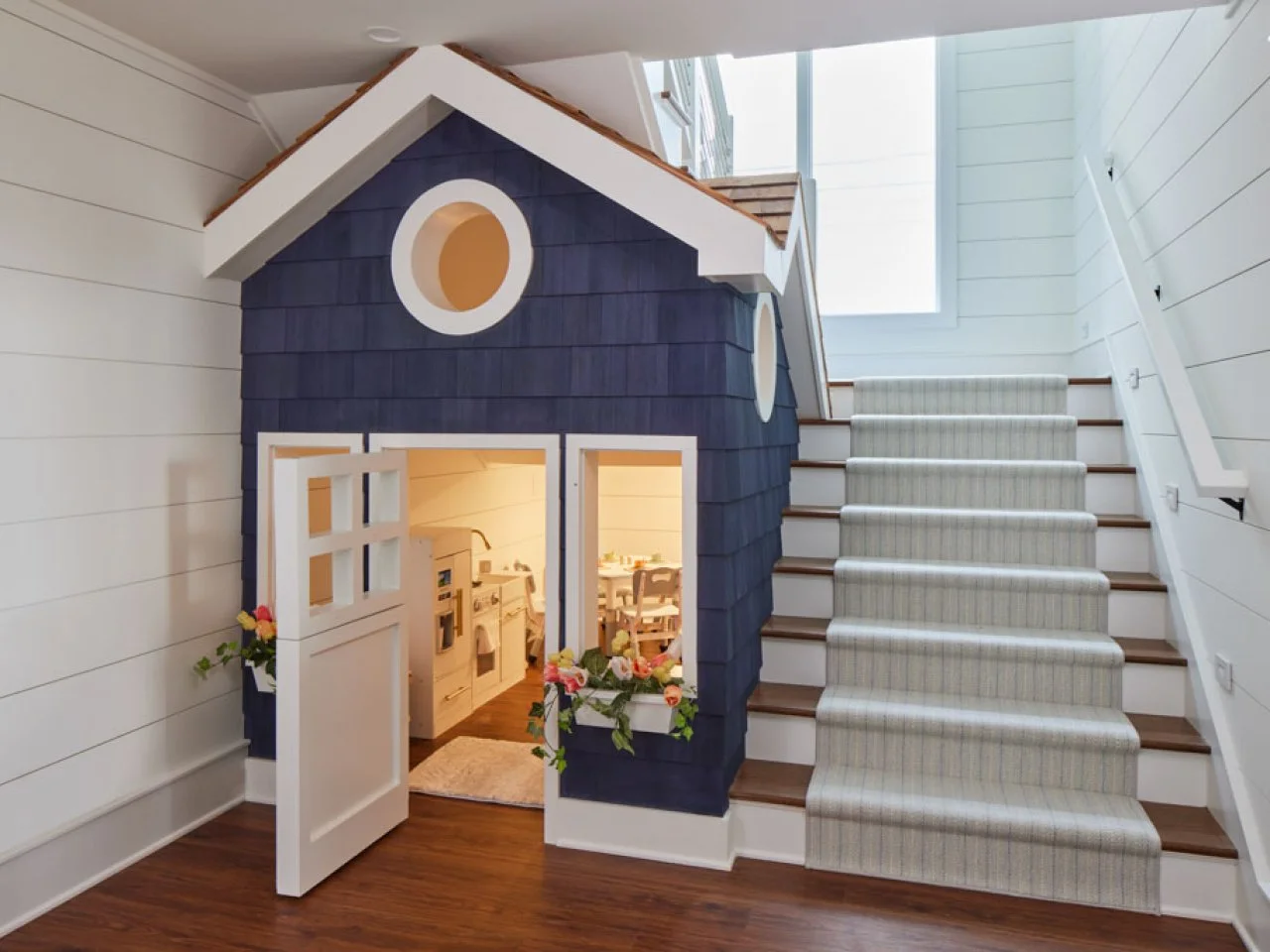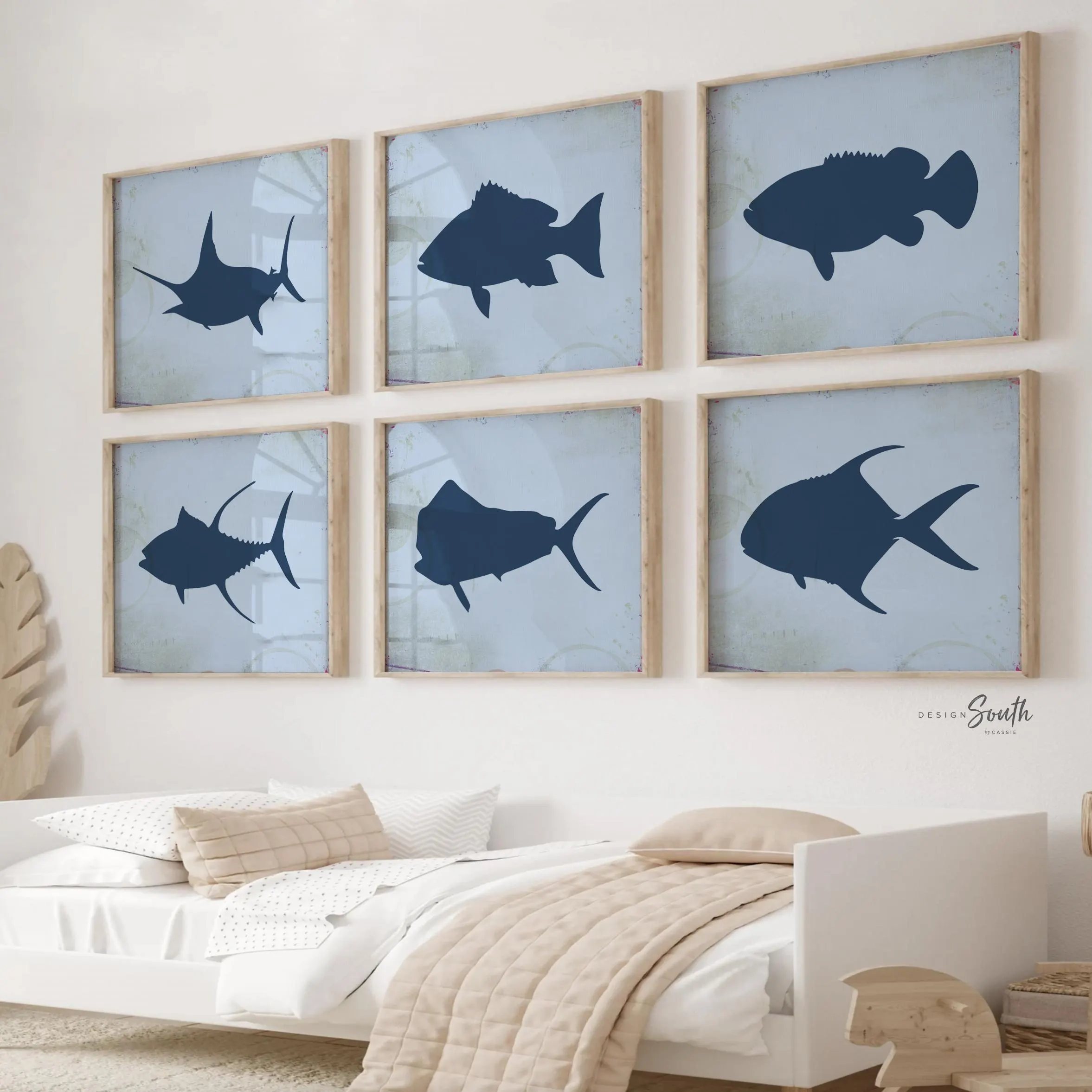Skip the decals. Walk through any Pulte community in Fishers, from Iron Pointe to Remington, or M/I developments across the city and you’ll find generous kids’ bedrooms with 10-foot ceilings and plenty of wall space. But most families fill that space with temporary solutions: character wallpaper that children outgrow, themed decals that peel and fade, or bold paint colors that look dated within months. The result is rooms that need constant updating as tastes change and children mature.
Smart families choose wall treatments that work from ages 4 to 14 without major renovations. Our Fishers kids’ room treatments use timeless trim and geometry that last through trends, sized to fit popular bedrooms in Pulte and M/I communities. These approaches create architectural interest that supports changing décor rather than dictating it, allowing rooms to evolve naturally as children grow.
From slat and box patterns that feel custom rather than trendy to hidden LED systems that make reading nooks magical, these wall treatments provide the foundation for spaces that adapt to homework needs, sleepovers, and teenage retreats. The investment pays dividends by creating rooms that feel intentional throughout childhood rather than requiring complete makeovers every few years.
Slat and Box Patterns That Work from Ages 4–14
Geometric wall treatments provide visual interest without the themed elements that quickly feel outdated. Horizontal slat patterns or box molding grids create architectural rhythm that works equally well behind a toddler bed or teenage desk setup. The key lies in choosing proportions that feel substantial rather than busy.
Horizontal wood slat treatments work beautifully in Pulte bedrooms with their generous 10-foot ceilings. Installing 1×4 slats with 2-inch spacing creates modern texture that photographs well for social media while providing practical benefits. The horizontal lines make rooms feel wider, perfect for standard Fishers bedroom dimensions around 11×12 feet. When painted in soft neutrals like warm gray or sage green, these treatments provide backdrop that supports any décor theme without competing.
Box molding systems offer more traditional appeal while maintaining timeless character. Picture-frame panels sized 24×36 inches work well on the standard 8-foot walls found in M/I communities, while larger 30×42 inch frames suit Pulte’s taller spaces. The panels can highlight artwork, provide backdrop for furniture arrangement, or simply add architectural substance to otherwise plain walls. When children transition from elementary to middle school interests, the frames adapt seamlessly to new posters, art projects, or photography.
Installation quality determines longevity and appearance. Slats must be perfectly level and consistently spaced to avoid amateur appearance, while box molding requires precise mitering and tight joints. Professional installation ensures these treatments look intentional rather than DIY, supporting the room’s overall design integrity as children grow and décor changes around them.
Hidden LED Shelf Details for Reading Nooks
Creating dedicated reading spaces within children’s bedrooms encourages literacy while providing cozy retreats for quiet time. Built-in shelving with integrated LED lighting transforms standard bedroom corners into magical reading nooks that children use throughout their developmental years.
LED strip lighting concealed beneath shelves provides warm, even illumination perfect for reading without creating harsh shadows. The strips should be positioned to wash light downward onto book pages rather than creating glare. Color temperature around 3000K provides comfortable warmth that doesn’t interfere with bedtime routines when dimmed appropriately. Quality LED systems include dimming capabilities and can be controlled via smart switches that children can operate independently.
Shelf proportions must accommodate books from picture books to textbooks as children advance through school years. Lower shelves positioned 18-24 inches above floor level work for early readers accessing their own books, while higher shelves can store reference materials or display items. Depth should measure 10-12 inches to accommodate various book sizes without wasting space. Pulte bedrooms often provide corner areas perfect for these built-in solutions.
The reading nook becomes more than storage when paired with comfortable seating and proper lighting. A built-in bench with storage underneath, cushioned for comfort, creates an inviting spot that children actually use. M/I bedroom layouts frequently include window areas that work perfectly for this treatment, combining natural light during the day with LED task lighting for evening reading. These nooks evolve from storytime spaces to homework areas to teenage retreats without requiring modification.
Durable Finishes and Touch-Up Tips After Sports Season
Fishers families know the reality of youth sports, muddy cleats, equipment bags, and active children who interact physically with their environments. Kids’ rooms need wall treatments that withstand this activity while maintaining their appearance through seasons of heavy use.
Paint selection makes the biggest difference in durability and maintenance. Semi-gloss finishes on trim elements resist scuffs and clean easily with household cleaners. Wall areas benefit from eggshell or satin finishes that balance durability with attractive appearance. Premium paints with built-in primers create more durable surfaces that resist chipping and wear. Keeping leftover paint properly stored allows for quick touch-ups without color matching issues.
High-traffic areas around doors, light switches, and furniture placement need extra protection. Chair rail molding installed 36 inches above floor level creates a natural barrier that prevents damage from chair backs or active play. Corner guards where walls meet can prevent damage from sports equipment or furniture being moved. These protective elements should integrate with the overall wall treatment design rather than appearing as obvious damage control.
Touch-up techniques require planning during initial installation. Keeping detailed records of paint colors, sheen levels, and application methods ensures successful repairs. Small containers of touch-up paint should be clearly labeled and stored properly to prevent drying or color shift. Professional painters often create sample boards showing the exact colors and finishes used, making future touch-ups accurate and seamless.
Regular maintenance prevents small issues from becoming major problems. Gentle cleaning with appropriate products removes dirt and fingerprints before they become permanent stains. Addressing small chips or scuffs immediately prevents them from growing larger through continued use. These practices keep wall treatments looking fresh through years of active childhood while avoiding the need for complete repainting.
Proportional Scaling for Standard Fishers Bedroom Dimensions
Most Fishers builders create kids’ bedrooms measuring 10×12 to 12×14 feet with ceiling heights ranging from 9-10 feet. These standard dimensions require wall treatments scaled appropriately to avoid overwhelming smaller spaces or appearing insignificant in larger rooms.
Horizontal treatments work particularly well in standard rectangular bedrooms where making spaces feel wider improves functionality. Slat treatments with spacing that relates mathematically to room proportions create pleasing rhythm. In a 12-foot wide room, using 4-inch slats with 2-inch gaps creates exactly 24 divisions across the wall—a satisfying mathematical relationship that feels intentional. Pulte bedrooms often benefit from this type of proportional planning.
Vertical elements must be sized carefully to ceiling height relationships. In rooms with 9-foot ceilings, vertical panels shouldn’t exceed 6-7 feet in height to maintain proper proportions. The remaining space allows for crown molding or ceiling detail without creating cramped appearance. M/I homes with standard ceiling heights benefit from these conservative proportional relationships.
Box molding systems require even more precise proportional planning. Panel sizes should relate to both wall dimensions and furniture placement. In a standard 11×12 foot bedroom, panels measuring 30×36 inches create appropriate scale while leaving space for furniture arrangement. The panels should be positioned to frame typical furniture placement, bed, dresser, desk rather than competing with functional room layout.
Corner treatments and transition details become critical in smaller spaces where every element affects the overall composition. Properly scaled wall treatments make standard Fishers bedrooms feel custom and intentional rather than generic, supporting the home’s overall value while providing children with spaces that feel special rather than ordinary.
Storage Integration Within Wall Treatment Systems
Effective kids’ room design combines style with serious storage needs that change as children grow from toys to clothes to school supplies to teenage collections. Wall treatments that incorporate storage solve practical problems while maintaining clean aesthetic lines.youtube.
Built-in cubbies within box molding systems create designated spaces for books, toys, and personal items without requiring additional furniture. These storage areas should be sized for specific purposes—deeper cubbies for bulky toys, narrower sections for books, and medium spaces for display items. When integrated properly, storage becomes part of the architectural composition rather than an obvious add-on feature.
Bench seating with hidden storage serves multiple functions in kids’ rooms. A window seat with lift-up cushions provides comfortable reading spot while hiding seasonal clothing, extra bedding, or out-of-season toys. The bench should be sized for actual use—at least 18 inches deep for comfortable sitting, with interior storage areas that accommodate real storage needs rather than just appearing functional.
Vertical storage solutions maximize space in standard Fishers bedroom dimensions. Floor-to-ceiling built-ins can include a combination of open shelving, closed cabinets, and specialized storage for specific items. The key is planning storage types for long-term use rather than current needs alone. Elementary school art supplies give way to high school textbooks, which eventually become college preparation materials.
Hidden storage maintains clean visual lines while providing substantial capacity. Panels that appear decorative but actually conceal storage keep rooms looking organized even when children aren’t naturally neat. These solutions work particularly well for items used occasionally but needed accessible—seasonal decorations, memory boxes, or special occasion clothing.
Technology Integration for Growing Digital Needs
Modern children’s bedrooms must accommodate changing technology needs from elementary tablets to teenage laptops and gaming setups. Wall treatments should anticipate these needs with built-in solutions that prevent rooms from becoming tangled with cords and equipment.
Charging stations integrated into wall treatments keep devices organized while providing easy access. Built-in cubbies sized for tablets, phones, and laptops can include interior electrical outlets and USB charging ports. Cord management through grouted channels or concealed conduit prevents visible wiring while allowing flexibility for changing device types. Pulte and M/I bedrooms benefit from planning these electrical needs during wall treatment installation.
Desk areas integrated with wall treatments create dedicated homework and computer spaces that grow with children’s needs. Built-in desk surfaces can be sized appropriately for available space while coordinating with overall wall design. Overhead shelving provides storage for school supplies and reference materials, while cord management keeps computer equipment organized.
Future-proofing technology integration requires considering how children’s digital needs change over time. Elementary students need simple charging solutions and perhaps a small desk area. Middle schoolers require more substantial computer workspace and storage for supplies. Teenagers need serious desk space, multiple device charging, and possibly gaming equipment storage. Planning wall treatments to accommodate this progression prevents the need for major modifications as children grow.
Smart home integration allows children to control their environment independently while parents maintain oversight. Smart switches for LED lighting, voice-controlled music systems, and automated window treatments can be integrated into wall treatment systems. These technologies should be planned during installation to ensure proper electrical infrastructure while maintaining clean visual appearance.
Why Timeless Approaches Work Better Than Themes
Theme-based kids’ rooms create immediate excitement but quickly become problems as children’s interests shift. Cartoon characters popular with 4-year-olds embarrass 8-year-olds, while color schemes chosen for elementary years feel childish to teenagers. Timeless wall treatments provide architectural foundation that supports changing themes rather than dictating them.
Investment value matters in Fishers’ competitive real estate market. Neutral, well-executed wall treatments appeal to future buyers regardless of their children’s ages or interests. Theme rooms can actually hurt resale value by appearing too specific or dated. Architectural details like quality trim work and built-in storage enhance property value while serving current family needs.
Psychological benefits of timeless design support children’s development better than overstimulating themed environments. Calm, organized spaces promote better sleep and concentration for homework. Children can personalize these neutral backdrops with artwork, photographs, and collections that reflect their current interests without competing with permanent wall treatments.
Budget considerations favor timeless approaches over themes that require frequent updating. Quality architectural treatments installed once serve children throughout their developmental years, while themed rooms often need complete renovation every few years to remain age-appropriate. The upfront investment in professional wall treatments pays dividends through years of use without additional major expenses.
Ready to Create Timeless Kids’ Spaces in Your Fishers Home?
At Radford Woodworks, we specialize in kids’ room wall treatments that work from preschool through high school. Our experience with Fishers floor plans from Pulte and M/I Homes ensures proper proportional relationships while creating the architectural details that make bedrooms feel custom rather than builder-grade.
Ready to move beyond temporary solutions to permanent style? Get your personalized quote now by calling (317) 739-8555 or visiting radfordwoodworks.com/contact.
Your children deserve rooms that grow with them. Let’s create wall treatments that provide the perfect foundation for childhood memories.







